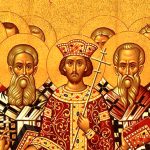After his last solo exhibition, at the Tel Aviv Museum of Art in 1960, Pinchas Litvinovsky retreated to his Jerusalem studio and spent the final decades of his life in solitude, searching for a visual language to express his newfound Jewish mysticism.
When the curator Amichai Chasson and the historian David Rozenson visited Litvinovsky’s boarded-up studio in the summer of 2023, they stepped into an art historian’s dream. Rozenson recalled a room filled with undiscovered artworks “of different sizes and shapes, some small and delicate, others large and imposing, with simply framed paintings spilling over from every crowded surface.”
The current exhibition, at Beit Avi Chai cultural center and art gallery in Jerusalem, “Pinchas Litvinovsky: You Must Choose Life—That is Art,” features a selection from this discovered cache among the 140 works on display from Litvinovsky’s dynamic seven-decade oeuvre in an ambitious endeavor to recover his faded legacy. Since he rarely titled and dated his work, the numerous galleries on three floors forgo strict chronological order and are organized instead according to stylistic tendencies and thematic motifs.
Litvinovsky entered the Odessa Art Academy in 1910, followed by a year at the Bezalel Academy in Jerusalem, and concluded his artistic training at the Imperial Academy of Arts in St. Petersburg at the height of Russia’s cultural “Silver Age.” When new pogroms swept across Russia, the artist and his wife, Liza, boarded SS Ruslan—the “Zionist Mayflower”—in November 1919 and settled in Mandate Palestine.
Litvinovsky’s aquarelles and oil paintings from the 1920s formally negotiated between the European avant-garde and a romantic orientalism that filtered the local people and landscapes through a naive, primitive lens. The Orange Seller (1925) depicts the Arab merchant and marketplace with Constructivist angularity, toned with a matted amber and tawny palette. Arab with a Flower (1926) and Woman with Donkey (1924) portray mundane scenes of daily life in bold, expressive colors and figures that seem to hover with a Chagallian, weightless serenity.
In the early 1930s, Litvinovsky traveled to Paris for several months, where his career took a decisive turn toward abstraction under the influence of Henri Matisse, George Rouault, and Joan Miró. Litvinovsky worked out his method of abstraction on hundreds of untitled canvases throughout the 1930s and ’40s, gradually reducing repetitive motifs, from Arab vendors to religious Jews, to primal elements contoured with vigorous brush strokes and bathed in vibrant colors.
Litvinovsky’s renown as a commissioned portrait artist during these decades (a job he despised) financially enabled his private abstract experiments. He made a living painting hundreds of portraits of cultural figures and world leaders, including Chaim Weizmann, Golda Meir, David Ben-Gurion, and Harry Truman. These works earned him the unofficial title of Israel’s “national portrait painter” and got him a studio in Jerusalem. When Moshe Dayan, the commander of the Jerusalem Haganah, picked up a portrait from Litvinovsky’s cheap hotel room, he pitied the artist’s dire conditions and arranged for a new accommodation on the top floor of a home previously used by the departed British deputy high commissioner. Litvinovsky lived and worked there from 1949 until he died in 1985.
In the 1950s, a spiritual journey redirected Litvinovsky’s artistic development. Looking back to the Judaism he had abandoned in his youth and melding its Kabbalistic doctrines with Eastern philosophy, Litvinovsky retreated to his new studio. He committed himself to finding pictorial expression for the mystical fusion that united, he believed, the passion of creation and the vitality of life.
The search for this expression can be seen in several series of oil paintings starting in the 1960s. Numerous untitled paintings in the Violinist series depict cartoonish images of the musician and his instrument through childlike, abstract shapes and masses of color. The recycled violin motif, borrowed from Marc Chagall as a symbol of Jewish identity, was equally influenced by the klezmer and classical music Litvinovsky listened to while at work in his studio.
An extensive series of rabbi portraits also presented an avenue through which Litvinovsky sought to merge the spiritual with the physical. Unlike his commissioned portraits, the paintings of rabbis, taken from black-and-white photographs, posed a challenging exercise in depicting inner passion, intellect, and turmoil through intense brush strokes and expressive coloring. Some portraits were drawn realistically, while others, such as Rabbi Simcha Bunim Bonhardt (undated) and Rabbi David Twersky (undated), burst with expressive energy and streams of color almost to the point of unrecognizability.
The capstone of Litvinovsky’s spiritual journey may be seen in a series of late artworks that integrate quotes from Jewish texts (in Hebrew) alongside the chaos of abstract figures. The most commonly used quotation was “you must choose life”—a divine command tracing back to the book of Deuteronomy that Litvinovsky understood according to the Talmudic interpretation that one must learn an art to sustain a livelihood.
In the large, oil-on-canvas You Must Choose Life—That is Art from the early 1980s, Litvinovsky depicts a sensual encounter through abstract, intertwined body parts under the words “you must choose life—that is art,” taken from the Jerusalem Talmud. As the other works in this series, the combination of words and dense, intertwined subjects conveys the spiritual and linguistic connection that binds together the Hebrew words for creativity, creator, and creation (“Bara,” “Boreh,” and “Beriah”).
Litvinovsky perceived the Talmudic expression “you must choose life, you must choose art” as a spiritual commandment to undertake creative work as a joyful celebration of life. In odd parallel to this creative drive, Litvinovsky retreated from public view in the final years of his life. He refused to fill out a 1970 questionnaire from the Israeli Ministry of Education and Culture asking artists to submit their biographies because he believed painters and sculptors were no different from other, anonymous craftsmen. When awarded the distinguished Israel Prize for painting in 1980, he remained behind the doors of his studio, sending his granddaughter to retrieve the award in his stead.
The impressive collection on exhibit at Beit Avi Chai, together with an insightful catalogue, recovers an important artistic legacy that the artist himself had tried to hide.


















